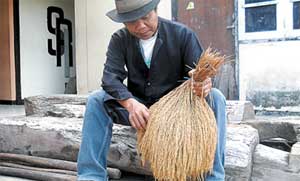 Nine Years Stored on the Ceiling Not Falling The onslaught of high-yielding rice varieties in the 1960s made a number of local rice varieties abandoned by the community.. Lucky, there are still residents who are persistent in preserving the local varieties of rice, one of them is Adi Purwadi, 44, Kemiren Village residents, Glagah District.
Nine Years Stored on the Ceiling Not Falling The onslaught of high-yielding rice varieties in the 1960s made a number of local rice varieties abandoned by the community.. Lucky, there are still residents who are persistent in preserving the local varieties of rice, one of them is Adi Purwadi, 44, Kemiren Village residents, Glagah District.
The rainy season in the early 1990s, which caused Adi Pur Wadi's house to leak, turned out to be a blessing for the man from the West Kemiren Hamlet., Kemiren Village, Kecamatan Gla gah, the. When the father of one child went up to the ceiling of the house to fix the roof of his house, Adi finds a bunch of rice that has a different grain shape than most rice.
Investigate, a bunch of rice with grains that tend to be round and the color of the golden skin is early arum rice. Adi is also happy, isn't it crazy. How not, This local variety of rice is a very rare type of rice. Yes, The green revolution that was launched by the government in the 1960s did make local rice varieties abandoned by the community. Farmers prefer to plant superior varieties of rice because the process from planting to post-harvest can be done instantly.
To harvest early arum rice, farmers have to cut the rice stalks one by one using aniani (a kind of small knife) This is done so that the length of the stalks is cut uniformly so that it is easier for the process of tying the rice stalks before drying. Otherwise, the process of harvesting superior varieties of rice can be done using a sickle that can cut the serum and rice trees at once.
Post-harvest handling of local varieties, including early maturing arum rice, also more complicated than superior varieties of rice. The process of threshing the local rice grains must be done by pounding it using a mortar. Otherwise, High-yielding varieties of rice grains can be knocked out with a rice thresher machine. “Local varieties of rice grains are very strong. That's why the process of threshing the local rice grains must be pounded in a mortar,"Adi said when met at his home last Sunday (16/9).
The man who is familiarly called Kang Pur added:, because local varieties of rice grains are very strong, he can still find a bunch of early arum rice that was previously used as a squeeze (a kind of expression of gratitude when building a house). "This house was built in 1981, and I found a bunch of used rice paddies while repairing a leaky roof tile in the early 90s. So, shelf life of about nine years. If rice varieties are superior, if kept that long, must have fallen," he explained.
From there, Kang Pur tries to cultivate the local type of genjah arum rice. The bunch of rice he found was sown with mud in a polybag. In yang, From a bunch of rice, only four seeds grow. In consideration of safety, Kang Pur put the polybag in the attic. "It is safe from ignorant hands and pest attacks".
But, padi da lam polybag that I put on top of the lo teng was even attacked by birds. Finally at harvest time only get a few stalks of rice," he said. He developed a few stalks of early arum rice from the first harvest. And so on until he succeeded in harvesting the prospective rice seeds in quite a large number. Next, The rice seeds are planted in an area of one thousand square meters. The man who is also a Banyuwangi cultural person admitted that he had several times enjoyed the results of the early arum rice harvest.
Some are cooked for daily food needs, others are sold and “loaned” to other farmers who want to grow the local varieties of rice. According to Kang Pur, The advantage of early maturing arum rice is that it lasts longer storage, expands more when cooked, and more punel. Another advantage, the rice smells good. Because of that, a number of buyers from certain circles are willing to spend a deeper check to buy the gen jah arum rice.
"I sell genjah arum rice twice as expensive as ordinary "A" quality rice. for farmers who "borrow" seeds, a bunch of borrowed rice, When harvesting, two bunches must be returned," he explained. The irony, now early maturing arum rice is experiencing a seed crisis again. This happened because the early maturing arum paddy field that was now planted by Kang Pur was attacked by rats. as a result, the rice fruit is only a few stalks left.
Lucky, Until now, there are still two farmers who have borrowed Kang Pur's early arum rice seeds, which haven't been harvested yet. "I'm sure the genjah arum isn't extinct yet. I am determined to continue to preserve local rice,” he said. In addition to developing early arum rice,, Kang Pur is currently trying to cultivate three other types of local rice varieties, of which the hoeng type, untup, dan pe lang.
Kang Pur admitted that he was assisted by several researchers from a number of leading universities in the country, One of them is Universitas Brawijaya, Poor. “I don't want to patent those local varieties. Because local rice is not my invention, because it's been there for a long time. I just want to do. I want to save local varieties of rice from extinction,"Put cash". (radar)
